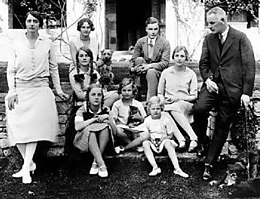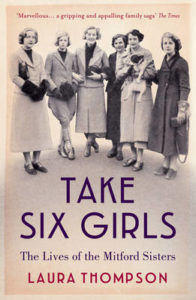When I told my colleague Annie that I had just finished Laura Thompson’s Take Six Girls, she quipped that you couldn’t make the Mitford sisters up. Born into an aristocratic British family between 1904 and 1920, the girls were many things: talented, beautiful, witty – and scandalous. Reflecting the opposing political currents of the time, two were fascists (Diana and Unity) and one a communist (Jessica), while Nancy became a world-famous novelist and Deborah a Duchess. Only the good-natured Pamela kept a low profile, preferring the slow, quiet pleasures of rural life to the limelight. Packed with comedy and tragedy in equal measure, it’s little wonder that the ‘Mitford Industry’ shows little sign of abating.
The last major group biography of the Mitford sisters was Mary S. Lovell’s The Mitford Girls (2001). Thompson’s book is heavily indebted to Lovell’s but, for my money, is the better of the two. Although her conservatism irksomely shows through here and there, Thompson’s prose is – not unlike Nancy’s – elegant and wry, with keen psychological insight and a good feeling for the eccentricities of the British upper class. Take, for example, this memorable description of the girls’ iconic status:
They are part Audrey Hepburn as Holly Golightly, part Patti Hearst in the Symbionese Liberation Army, part Country Life girls in pearls, part Malory Towers midnight feasters, part marble frieze of smiling young goddesses. Their significance has become detached from the realities of their own times, and is now a significance of image; as most things are today.
Thompson’s book is useful and pleasurable because it fully situates the Mitfords in their time and place, a polarised society – not unlike ours – shaped by furiously partisan politics and a strengthening far right. For once, too, Unity’s tragedy is given its full human dimension, the Hitler fanatic portrayed neither jokingly nor sympathetically but rather as a complex and rather sad figure.
Of course, though, it is Diana and Nancy – the ‘white and black queen’ of the Mitford girls, in Thompson’s phrase – who dominate the book. Thompson maps out their very different journeys with plenty of revealing detail, charting the darkly fascinating Diana’s all-consuming passion for the British fascist leader Oswald Mosley, and Nancy’s descent into the hellish illness that would claim her life.
Whatever one thinks of the Mitford sisters – and there is plenty to dislike in their unearned privilege and attraction to abhorrent ideologies – ‘it is impossible,’ as Thompson writes, ‘to find them boring’.
 The Mitford family.
The Mitford family. 